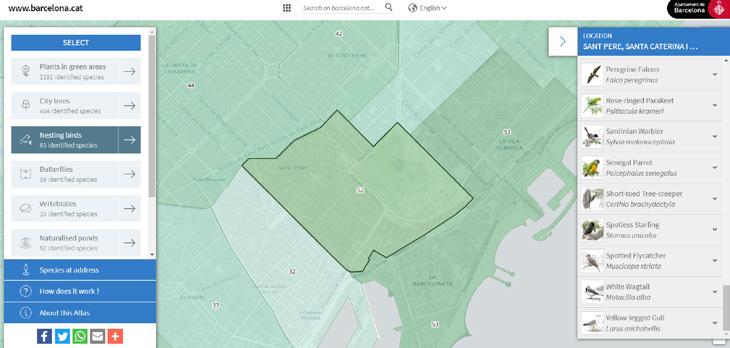
2 minute read
Data and Variables
4. Data and Variables
This work aims at increasing urban biodiversity in the city of Barcelona through the creation of green corridors that connect el Parc de la Ciutadella with the inner parts of El Born. We were faced with two main challenges: deciding on the paths that should be converted into corridors and then designing the corridors themselves in order to increase biodiversity.
Advertisement
Urban Biodiversity Our work is based on Urban Biodiversity Atlas5 that was generated by the Barcelona’s Ayuntamiento. The Atlas contains an index of species that have been observed to inhabit the City of Barcelona. The findings within the Atlas are organized by types of species and by their associated location within the city. Based on this data, we where able to generate our first Indicator: The Urban Biodiversity Index. The Urban Biodiversity Index shows the rate of species diversity within a given area6. From this data we also generated a short-list of species that was then used as case studies to design our green spaces (see Image 4 & 5).
Image 4: Biodiversity Atlas web page Ajuntament de Barcelona

Erithacus rubecula Rosmarinus officinalis Pipistrellus pipistrellus
Image 5: Some species that can be found in Barcelona NDVI The second type of data that we used was a Normalized Difference Vegetation Index (NDVI) of the city of Barcelona7. NDVI is a remote sensing technique that uses infrared and near-infrared to help assess the levels of photosynthesis in plants. The NDVI of Barcelona helped us cement our case for the study area. El Born, as the product of an urban expansion of a different era, was not designed with the same focus on public amenities or the quality of urban space as other urban expansions of the city (namely El Eixample). The NDVI analysis showed the area of El Born as one of the poorest performing areas in the whole city, mostly due to the sheer absence of greenery (see Image 6).
Urban Form The third type of data we used in our study was that of the formal configuration of the urban fabric. In order to fully understand the way in which EL Born, from a tectonic perspective, works we needed to recreate its form in three dimensions. This allowed is to, not only analyze the urban fabric, but to also propose interventions and visualize their effects on the urban fabric (see Image 7).

Image 6: NDVI El BORN
Image 7: El Born Morphology





